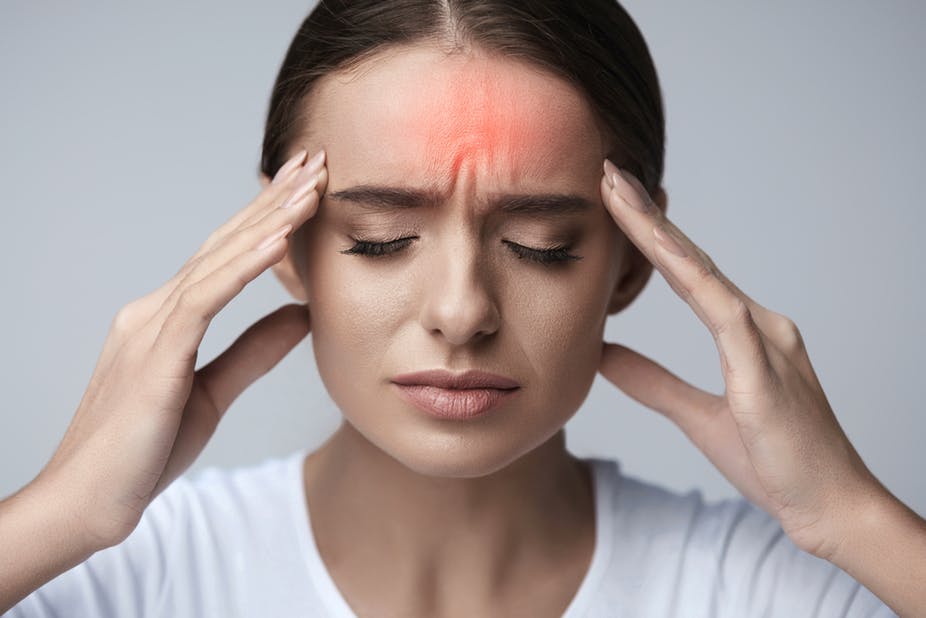It’s very common for people to confuse tension headaches with migraines. While both can cause significant discomfort, they have distinct characteristics. Here’s a breakdown to help differentiate between the two:
Tension Headaches:
- Description:
- Tension headaches are the most common type of headache.
- They’re often described as a feeling of a tight band or pressure around the head, or a dull, aching pain.
- The pain is typically mild to moderate.
- Symptoms:
- Dull, aching head pain.
- Tightness or pressure across the forehead, sides, or back of the head.
- Tenderness in the scalp, neck, and shoulder muscles.
- Characteristics:
- Usually affects both sides of the head.
- Generally not accompanied by nausea or vomiting.
- May have sensitivity to light or sound, but it’s not common.
- Physical activity typically doesn’t worsen the pain.
- Triggers:
- Stress.
- Poor posture.
- Muscle strain.
- Fatigue.
Migraines:
- Description:
- Migraines are more severe than tension headaches.
- They often involve throbbing or pulsating pain.
- They can significantly disrupt daily activities.
- Symptoms:
- Throbbing or pulsating pain, often on one side of the head.
- Nausea and/or vomiting.
- Sensitivity to light, sound, and smells.
- Visual disturbances (aura), such as flashing lights or blind spots, may occur.
- Characteristics:
- Often affects one side of the head.
- Pain can be moderate to severe.
- Physical activity usually worsens the pain.
- Triggers:
- Stress.
- Hormonal changes.
- Certain foods and drinks.
- Changes in sleep patterns.
- sensory stimuli.
Key Differences Summarized:
- Pain:
- Tension headaches: Dull, aching, pressure.
- Migraines: Throbbing, pulsating.
- Location:
- Tension headaches: Usually both sides.
- Migraines: Often one side.
- Associated Symptoms:
- Tension headaches: Minimal or none.
- Migraines: Nausea, vomiting, sensitivity to light and sound, aura.
- Severity:
- Tension headaches: Mild to moderate.
- Migraines: Moderate to severe.
When to Seek Professional Help:
It’s important to consult a healthcare professional if you experience:
- Sudden, severe headaches.
- Headaches accompanied by fever, stiff neck, confusion, seizures, or vision changes.
- Frequent or chronic headaches that interfere with your daily life.
How Does Chiropractic Care Help?
Chiropractic care offers a valuable approach to addressing tension headaches, primarily by focusing on the musculoskeletal system. Here’s how it can help:
1. Addressing Musculoskeletal Imbalances:
- Spinal Adjustments:
- Tension headaches often stem from issues in the cervical spine (neck). Misalignments or restrictions in these vertebrae can lead to muscle tension and pain.
- Chiropractic adjustments aim to restore proper alignment and movement to the spine, reducing muscle strain.
- Muscle Tension Relief:
- Chiropractors use various techniques, including manual therapy and soft tissue work, to release tension in the muscles of the neck, shoulders, and upper back.
- This can alleviate the tightness and pressure that contribute to tension headaches.
2. Improving Posture:
- Postural Correction:
- Poor posture, especially from prolonged desk work or screen time, can place significant stress on the neck and upper back muscles.
- Chiropractors can assess your posture and provide guidance on ergonomic adjustments and exercises to improve it.
- Reducing Strain:
- By correcting postural imbalances, chiropractic care helps to distribute weight more evenly, reducing strain on the muscles that contribute to headaches.
3. Reducing Stress:
- Nervous System Regulation:
- Chiropractic adjustments can have a positive impact on the nervous system, which plays a role in stress response.
- By reducing nervous system irritability, chiropractic care may help to decrease the frequency and intensity of stress-related tension headaches.
- Promoting Relaxation:
- The manual therapy and soft tissue work involved in chiropractic care can promote relaxation and reduce overall muscle tension, contributing to headache relief.
4. Providing Holistic Care:
- Identifying Triggers:
- Chiropractors often take a holistic approach, considering factors such as lifestyle, stress levels, and ergonomic factors that may contribute to headaches.
- They can provide advice on lifestyle modifications, exercise, and stress management techniques.
- Preventive Measures:
- Chiropractic care can help to prevent future tension headaches by addressing underlying musculoskeletal issues and promoting healthy habits.
In essence, chiropractic care seeks to address the root causes of tension headaches, rather than simply masking the symptoms. By focusing on musculoskeletal health, posture, and stress reduction, chiropractors can provide a valuable and drug-free approach to headache relief.
We’re Happy To Help
Chiropractors can play a role in helping to alleviate tension headaches, especially those related to musculoskeletal issues in the neck and upper back. They can also help to identify contributing factors, such as posture and stress. Dr Michael Black and Dr David Black will be pleased to offer their help in finding the cause of your headache at their Armadale and Doncaster chiropractic clinics. Call 9509 7691 or book online from our home page.

